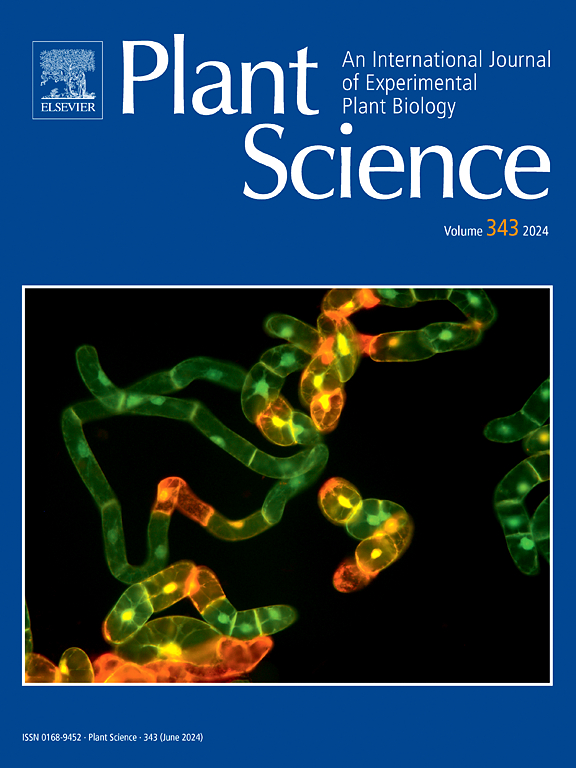花前喷磷提高热胁迫菜豆的繁殖和种子产量。
IF 4.2
2区 生物学
Q2 BIOCHEMISTRY & MOLECULAR BIOLOGY
引用次数: 0
摘要
气候变化加剧了热浪,威胁着全球粮食安全。普通豆(Phaseolus vulgaris L.)在开花期间对热浪高度敏感,热浪破坏了源库关系,降低了花粉活力,降低了种子产量。在热浪期间,磷(P)缺乏进一步限制了碳水化合物向生殖组织的运输。本研究评价了叶片喷施磷对4 ~ R6花期缺磷(PD)和足磷(PS)普通豆科植物热浪效应的缓解效果。全因子试验评估了开花期间两种底物磷的有效性(PD和PS),花前期两种叶片喷磷处理(不喷磷,P;施磷肥(+P),花期有两种温度模式:对照(28/18°C,日/夜)和高温(38/28°C,日/夜)。叶片磷防治喷施提高了光化学效率,降低了氧化胁迫,避免了高温条件下光合色素含量的下降。施磷植株花粉粒淀粉沉积量大,可溶性碳水化合物浓度高,高温对细胞的伤害较小。结果表明,在高温条件下,喷施叶片磷可以通过提高生殖结构中可溶性碳水化合物的供给来维持花粉活力,从而提高种子产量。上述研究结果表明,喷施磷能通过提高普通豆的生殖弹性和产量稳定性,缓解开花期间的高温和磷获取障碍。本研究强调了在气候变化引起的热浪条件下,在关键物候阶段预防性喷施叶片磷的潜力。本文章由计算机程序翻译,如有差异,请以英文原文为准。
Pre-anthesis phosphorus sprays boost reproductive development and seed yield in heat-stressed Phaseolus vulgaris L.
Climate change intensifies heat waves, threatening global food security. Common bean (Phaseolus vulgaris L.) is highly sensitive to heat waves during flowering, which disrupts source-sink relationships, reduces pollen viability, and diminishes seed yield. Phosphorus (P) deficiency further limits carbohydrate transport to reproductive tissues during heat waves. This study evaluated the efficacy of leaf P spraying in mitigating heat wave effects in common bean plants facing P deficiency (PD) and P sufficiency (PS) during flowering, i.e., phenological phases V4 to R6. A complete factorial experiment evaluated two substrate P availability during flowering (PD and PS), two leaf P spraying treatments applied during the pre-anthesis (without P spraying, -P; and with P spraying, +P), and two air temperature regimes during flowering: control (28/18 °C, day/night) and heat wave (38/28 °C, day/night). Preventive leaf P spraying improved photochemical efficiency, reduced oxidative stress, and avoided decreases in photosynthetic pigment content under heat wave. P-sprayed plants exhibited greater starch deposition in pollen grains and higher soluble carbohydrate concentration, showing less cellular damage caused by heat wave. As a result, leaf P spraying also increased seed yield under heat wave by sustaining pollen viability owing to improved supply of soluble carbohydrates to reproductive structures. These findings underscore the critical role of leaf P spraying in alleviating heat wave and impaired P acquisition in common bean during flowering by enhancing reproductive resilience and yield stability. This study highlights the potential of such a strategy of preventive leaf P spraying at critical phenological phases to improve crop performance under heat wave conditions caused by climate change.
求助全文
通过发布文献求助,成功后即可免费获取论文全文。
去求助
来源期刊

Plant Science
生物-生化与分子生物学
CiteScore
9.10
自引率
1.90%
发文量
322
审稿时长
33 days
期刊介绍:
Plant Science will publish in the minimum of time, research manuscripts as well as commissioned reviews and commentaries recommended by its referees in all areas of experimental plant biology with emphasis in the broad areas of genomics, proteomics, biochemistry (including enzymology), physiology, cell biology, development, genetics, functional plant breeding, systems biology and the interaction of plants with the environment.
Manuscripts for full consideration should be written concisely and essentially as a final report. The main criterion for publication is that the manuscript must contain original and significant insights that lead to a better understanding of fundamental plant biology. Papers centering on plant cell culture should be of interest to a wide audience and methods employed result in a substantial improvement over existing established techniques and approaches. Methods papers are welcome only when the technique(s) described is novel or provides a major advancement of established protocols.
 求助内容:
求助内容: 应助结果提醒方式:
应助结果提醒方式:


